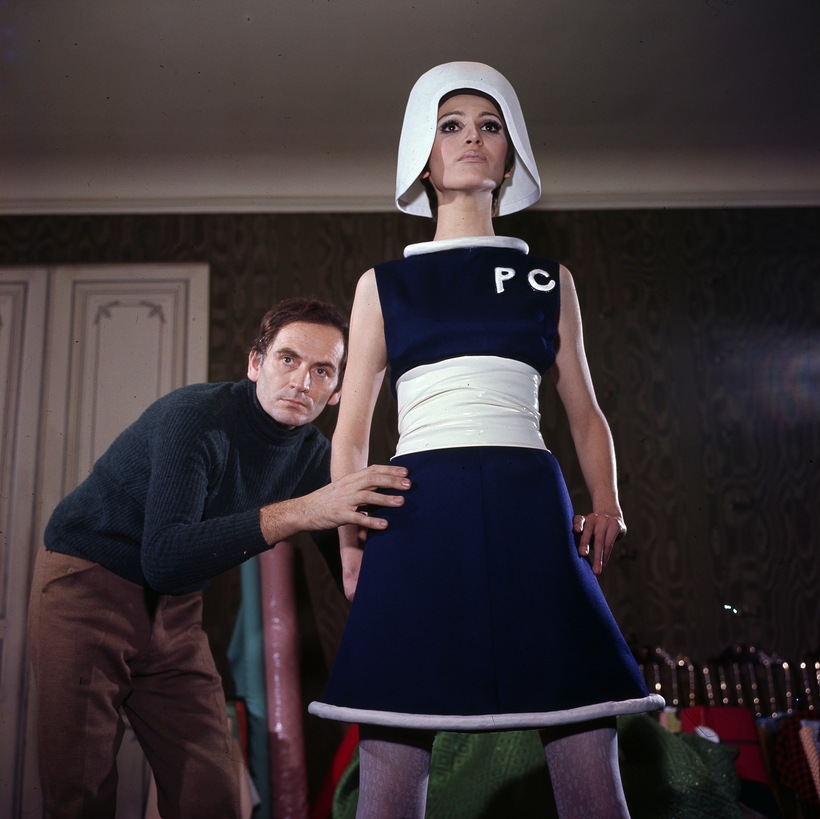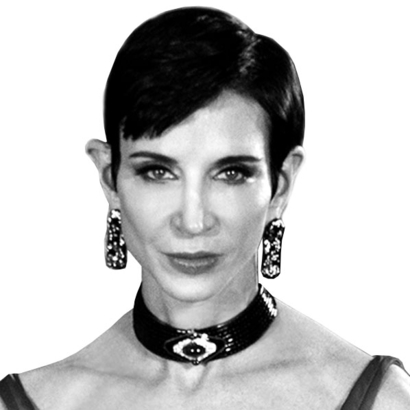At 98, Pierre Cardin has existed for so long as both a person and a brand that he has considered himself at least as much an “element” as a “human being.” And if, as he says, he is an element, then surely he must be gold. By his own estimation, over the course of his career he has employed around 90,000 people in 63 countries, and has stamped his insignia on about 800 products ranging from ball gowns to AMC Javelins and electric razors.
To appreciate the oracular Cardin, who launched his own business in 1950 with the benediction of his mentor, Christian Dior, it is helpful to recite a partial litany of some of his “firsts.” Cardin was the first haute couturier to sell ready-to-wear, at the Printemps department store, in 1959—an insurgent maneuver that precipitated his expulsion from the Chambre Syndicale de la Haute Couture. He was the first to exploit comprehensively the lucrative practice of licensing, and to recognize the marketing power of a visible logo. He was the first Western designer to bring his wares to the Far East, at a time when Chinese citizens were still in Mao uniforms. A longtime enthusiast of space travel, Cardin was the first civilian permitted to walk in Buzz Aldrin’s NASA moon suit.
With the on-demand release next week of the synoptic documentary House of Cardin, audiences can watch the nonagenarian as he time travels, too—back to the Veneto, Italy, where he was born, and forward to his projected Palais de Verre, a futuristic structure he envisions for Venice, stopping along the way at such peak points as his early-60s liaison with Jeanne Moreau and his 1981 acquisition of Maxim’s. Long ago, Cardin chose the circle, a symbol of eternity, as a leitmotif of his clothing, furniture, and architectural designs. Unlike the square or triangle, this perfect geometric form, he explains, “has no end.” And neither, it seems, does the fable of Cardin. The secret of his miraculous longevity, says this iconoclast, who in all his years in business has never borrowed a sou, is “work, work, work. It is the only reason to be happy in life.”
On the occasion of the release of House of Cardin, Pierre Cardin shares his reflections on the past, present, and future with Air Mail.
AIR MAIL: Monsieur Cardin, you helped all of us imagine a better tomorrow. As a philosopher of the future, please tell us your thoughts about the current dystopian state of affairs—the pandemic, political discord, economic disaster for many. Please square your ideas of the future with the present day. Are you still optimistic?
PIERRE CARDIN: I don’t get involved with politics. I see a positive future because history has shown me that we can surpass crises.
AIR MAIL: What design of yours would you most like to see worn by as many people as possible today?
CARDIN: I hope it would never be military uniforms again.
AIR MAIL: What did you absorb from working with the great aesthetes Christian Bérard, Jean Cocteau, Christian Dior?
CARDIN: Elegance and creativity.

AIR MAIL: Here in New York, at least, people promenade on the streets in what a generation ago would be considered their underwear: tank tops, old T-shirts, shorts, flip-flops. What is the cause of this decline in the art of self-presentation? What will it take to get people out of their sweats and back into beautiful, inventive, disciplined designs, such as those you have created?
CARDIN: People are looking for freedom today through simplification of clothing, which makes them all look homogeneous, contrary to fashion that creates a strong identity and makes you free to express yourself.
AIR MAIL: Far in advance, you foresaw the present global fashion system and global economy. Where will it take us now?
CARDIN: As you say, I began prêt-à-porter or ready-to-wear, and I hope in the future there will be other new ways combined with an ample perspective. We can’t forget that the future is created by people.
AIR MAIL: Many years ago you imagined “unisex” clothing designs. You have also been known for your exceptional romantic partners, both male and female. What are your thoughts about the recent rise of gender fluidity, the mainstreaming of transgender people, and the #MeToo movement?
CARDIN: One day a woman stated that she would like to wear pants, and shortly after that others followed and pants became a social and economic statement. The cause found a solution to the problem.
AIR MAIL: You are known for working early on with Black models and models of color, and for diversity in your cabine. How do you expect the Black Lives Matter movement to alter our attitudes toward race? How does B.L.M. compare to other, earlier human-rights movements, from civil rights to feminism to gay rights?
CARDIN: The problem will find its solution thanks to the intelligence and the sensitivity of people.
AIR MAIL: How do you think the intrusion of social media into our lives is altering us as human beings?
CARDIN: I prefer direct human contact, and I fear that technological evolution finds us unprepared because it develops too rapidly.
AIR MAIL: You have long been an enthusiastic patron of the performing arts. What developments would you like to see happen in theater, dance, music?
CARDIN: An international collaboration between international private and public operators where individualism is the only prerogative of artists and authors.
AIR MAIL: I am very curious to know your thoughts on two pillars of the American fashion industry, both of whom held you in very high regard—Eleanor Lambert and Geoffrey Beene. Like you, Mr. Beene always had great faith in the future. You were at a certain point a client of Eleanor’s as well as her friend.
CARDIN: She was a journalist and close friend of mine. Geoffrey was a great friend as well. We shared a positive vision of the future, and he was the only one to encourage me to create ready-wear.
AIR MAIL: I admire [Cardin’s head of couture, muse, and ex-model] Maryse Gaspard very much, not only for her loyalty to you but for her incomparable chic. What do you think makes a person chic and why do we not see that rare breed so much anymore?
CARDIN: Maryse is one of the most elegant women of the world. Today women work. Years ago they wanted to be populaire and be seen; now rich women must relate to the working class.

AIR MAIL: When the pandemic began, I immediately started wishing for a Pierre Cardin–designed mask or face shield. Can you please come up with a design that would surprise and delight us, and keep us safe and elegant? What would that look like?
CARDIN: I prefer to think that soon the mask won’t serve us anymore!
AIR MAIL: What was the naughtiest thing you ever did in your life, or would like to do now?
CARDIN: The most provocative thing was ready-to-wear. Now? I’ve done almost everything!
AIR MAIL: As an actor manqué, do you like watching yourself on film, in the documentary?
CARDIN: While watching the images of my past in the documentary, I felt good and also uncomfortable.
AIR MAIL: What is the greatest change for the better that you have seen happen in your lifetime? For the worse?
CARDIN: Equality between men and women is the greatest. I never think of the worst-case scenario.
AIR MAIL: Strange coincidences occurred in your life from your very first day in Paris. Would you consider yourself superstitious, religious, agnostic?
CARDIN: Coincidences surprise me, but I am a realist.
Amy Fine Collins is an Editor at Large for AIR MAIL and a Special Correspondent for Vanity Fair. She lives in New York City


